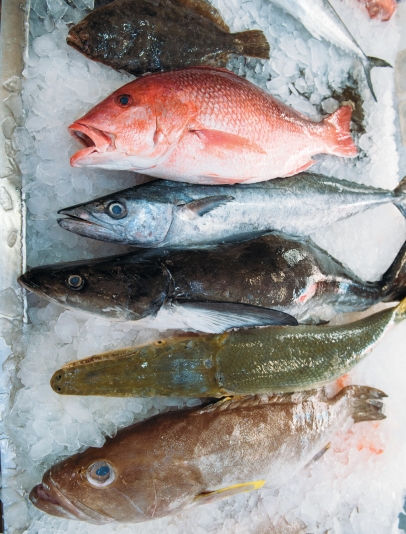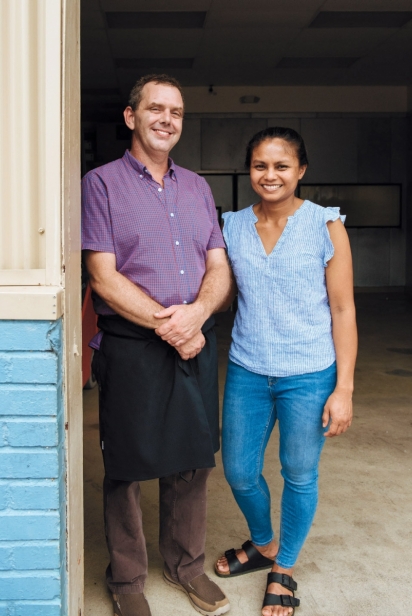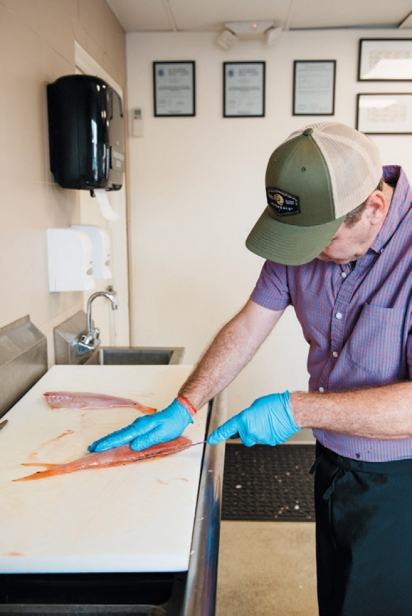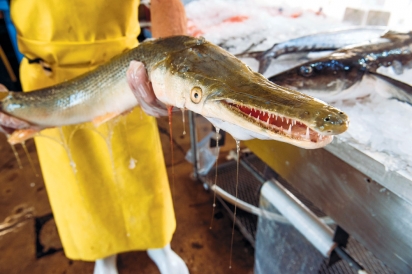Texas Seafood We Should Be Eating Now
Local couple stretch boundaries in new book
Did you know that the inshore lizard fish looks like a legless skink with gills? Or that the Atlantic tripletail really has only one tail? Or that sea robins, boxy spiked fish that forage on clams and shrimp, would make an excellent bouillabaisse? Have you tried Texas bluefish wrapped in bacon and smoked? Or ever kept the black drum’s guts? That’s right: Don’t discard the liver, roe, milt or swim bladders. Instead, cook ’em up!
These are tidbits from Texas Seafood: A Cookbook and Comprehensive Guide by PJ and Benchalak Srimart “Apple” Stoops out now.
Consciously modeled after Alan Davidson’s seafood books (Stoops greatly admires the author: “He knew and loved his fish”) it’s a book full of facts about fish and other seafood found in our local marine waters, including descriptions, availability and how to cook and eat them.
“We have this treasure here,” says PJ. “I like to think that we can go to the beach and be lucky enough to see this amazing bounty that apparently, most of us don’t even know is there. Some people do. The people who do are often immigrants, from anywhere in the world, who tend to approach this bounty with ‘Ohh, there’s a lot of good stuff to eat here.’ Not a lot of Texans approach it like that. And that is a shame.”
PJ is Texan; his wife and partner, Apple, hails from Isan, Thailand’s northeastern region that put local favorites like som tam (shredded green papaya salad) and larb (ground meat mixed with lime juice, fish sauce, fresh herbs and crunchy roasted rice) on Thailand’s culinary map. She comes from a culture where whole-animal eating is customary.
“We deep-fry whole fish, or steam it. We never eat just the fillet, or only part of the fish. We eat everything of the fish,” says Apple. “Or we use it to make fish sauce.”
“I didn’t grow up doing any of that,” says PJ. “In fact, I did not like seafood, growing up.” For me, it took moving to France to first realize: Seafood is delicious.”
PJ and Apple met in Thailand, fell in love, married and decided to move to Texas together. They settled in Lake Jackson, where they began a fishmonger business. This was back in 2007. PJ spend his time on the docks, waiting for fishing boats to return so he could buy their catch to resell from the back of his truck. His reputation for excellent fish rapidly grew, and soon he counted restaurants in Austin and Houston among his regular customers. Fish mongering aside, PJ and Apple themselves—along with their two young kids—enjoyed angling from docks, wading into the water or taking out a small boat. Whatever they caught, they took it home and cooked and ate it—and made mental notes: How did it taste, what texture was that fish, did it have many bones, and other detailed observations.
PJ’s reputation as fishmonger spread and by 2013 he was widely known as the “fish guy” who knew everything about Gulf fish and—quite literally—put bycatch on Houston menus: Whatever bycatch he had, he’d deliver it to chefs like Bryan Caswell, Richard Knight, Chris Shepherd and Justin Yu. In fact, that’s how I first heard about PJ Stoops: His salt-preserved brotula (same technique as bacalao; the recipe is in the book) was served at a farm dinner I attended at Knopp Branch Farm led by Knight, back in March 2014. For Stoops, eating and promoting bycatch is not “for the sake of something new, nor is it to test boundaries.” It comes from an awareness that for a sustainable fish future, we need to fish and manage with an appreciation that these resources are finite.
Dock and kitchen have always been closely connected for the Stoopses, cooking the widest variety of fish being such an integral part of enjoying the day’s catch. They made the jump to a restaurant kitchen in 2015, when they became the culinary team behind Foreign Correspondents. The restaurant made it to top 10 “best new restaurant” spots nationwide in no time but unfortunately fell victim to the restaurant group’s financial troubles and shuttered unexpectedly. Still, Houstonians got a delicious taste of what Apple’s regional cuisine was like, prepared with locally sourced ingredients—and we wanted more. At Sap Sap they ran regular pop-up dinners until new jobs and a book deal kept them otherwise engaged.
The vast majority of the cookery in the book is all Apple, says PJ. She’s the creative brain, the culinary component; he’s the nerd, the fact collector, the data guy: “Ohh, I love facts and trivia. I admit it, I enjoy the research.” They inspire each other. “In terms of sheer volume, I’ve seen more of these fish than Apple has, mostly because I was on the docks all the time. As far as the rest of it, Apple is much better at recalling what a fish tasted like, or how to cook it.”
As a Texan, he wouldn’t even think about eating a mullet’s innards, let alone discover that they taste better than a chicken’s. “NO way,” he agrees. Apple smiles. “PJ brought home different fish all the time, and I would cook it in as many different ways as I could.”
But unless you’re a recreational fisher with the proper permits, it’s hard to come by most Gulf fish in Texas. Commercial fishing is bound by target fish quota, and even if you go dockside for fresh fish right off the boat, what’s available depends on what (if anything) they caught along with the target species.
“On the East and West Coasts, multispecies and seasonal fisheries abound, and there are a lot of commonly targeted species. Here in Texas, fisheries are completely different. Very few seasonal fisheries exist, even fewer fisheries that target multiple species. There are many reasons for that. One of them is the lack of a broad, high-value market. Until the last few decades, Texas overall was not a fish-eating state. Also, 20 years ago, Houston didn’t have a reputation as a ‘food destination’ yet. Now that it has, and chefs are sourcing more local fish, and expanding the Gulf seafood focus on the menu, perhaps seafood companies—and Gulf fish variety along with it—are catching up with that.”
By documenting in such detail what’s below the surface in our Texas waters, the book reveals a treasure. Not just for a local market but beyond: the national and even global market. Says PJ: “We get seafood from all over the world here. There’s no reason why we couldn’t do the same with our fish.”
WANT TO BUY FRESH SEAFOOD? PJ STOOPS SUGGESTS:
Blue Horizon
2516 Wroxton Rd., Houston, 713-942-1055
Katie’s Seafood Market
(katiesseafoodmarket.com)
1902 Wharf Rd., Galveston, 409-763-8160
Captain Mark’s Seafood
602 W. 2nd St., Freeport, 979-233-0555
Super H-Mart
(hmart.com)
1304 Blalock Rd., Houston, 713-468-0606 9896
Bellaire Blvd., Houston, 713-270-1110









